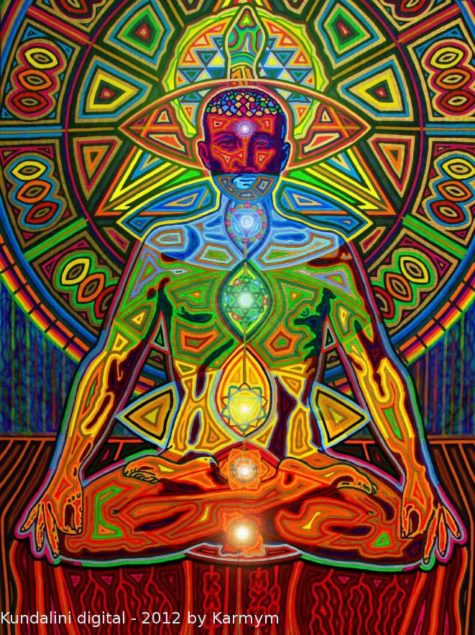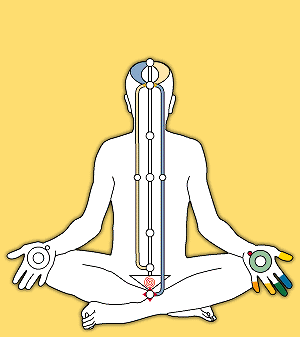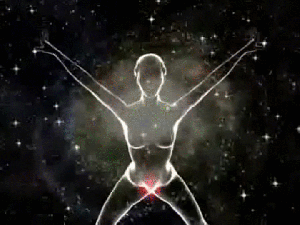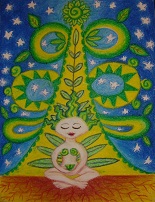Kundalini
Kundalini and The Chakras

Chakras, meaning “wheel”, are psychic centers that lie along the axis of the spine as consciousness potentials. They are usually represented as lotuses. The chakras are not materially real and are to be understood as situated, not in the gross body, but in the subtle or etheric body. Repositories of psychic energies, they govern the whole condition of being.
What is most commonly known is a more recent system dating to around the eighth century C.E. with the main 7 chakras. But the ancient spiritual Indian texts refer to various other systems with variations in the number of chakras and their location.
When kundalini is struck, she awakens, uncoils and begin to rise upwards like a fiery serpent, breaking upon each chakra as she ascends, until the Shakti merges with Shiva in sahasrara chakra.
As kundalini reaches each chakra, that lotus opens and lift its flower; and as soon as she leaves for a higher chakra, the lotus closes its petals and hangs down, symbolizing the activation of the energies of the chakra and their assimilation to kundalini. The dynamization of kundalini when it passes from one chakra to another is an unfoldment of spiritual consciousness stage by stage and is said to enable the acquirement of yogic powers called siddhis.
The increasing number of lotus petals, in ascending order, may be taken to indicate the rising energy or vibration-frequencies of the respective chakras, each functioning as a transformer of energies from one potency to another. Each of the 50 petals of the first 6 chakras are associated with one of the letter of the Sanskrit alphabet.
Each of the chakras, according to the Tantras, corresponds to one of the elements of which the known world is compounded. Muladhara represents solidity; Svadhisthana, liquidity; Manipura, the gaseous; Anahata, the aerial; Vishuddha, the etheric, or space. One can see the whole process as a progressive transformation of the elements, with an increase of volatility. Each of the elements of the first five chakras are associated with a sound: Lam, Vam, Ram, Yam, Ham.
This ascent through the chakras can be viewed as an upward journey through the self which refines and subtilizes the energy that is the kundalini, until at the sixth chakra, the Ajna, center of command, a qualitative change has taken place. The chakras are centers of transformation of psychic or mental energy into spiritual energy.
Source: Tantra-Kundalini
Chakra Meditation
There is a special type of concentrative meditation which we will call ‘Chakra meditation’. This is basically Kundalini yoga — the practice of causing psychic energy (Kundalini) to flow up Sushumna, energizing the various Chakras along the way.
The Sushumna is the central energy channel or Nadi that travels the full length of the middle of the spinal cord. It is the channel through which pranic energy flows and through which we experience Kundalini Awakening.
The practice, considered dangerous by some, will produce definite physiological sensations and psychological effects if continued long enough. It should not be attempted by epileptics or persons with an unstable mental or physical condition, or with heart disease. Certain drugs and medications, such as those used to treat epilepsy may retard progress.
Although the technique is very simple, it may eventually produce powerful results. Results may at first appear hours after the practice during sleep. As each Chakra is energized by this practice, it is said to add occult powers (sidhis), until at last the crown Chakra is reached, and with it, full enlightenment is attained. Sometimes Kundalini awakens all by itself.
To practice this Chakra meditation, you simply concentrate on the Chakras, beginning with the root Chakra, and moving progressively up, as you visualize psychic energy from the root Chakra traveling up Sushumna and vivifying each higher Chakra. As we mentioned the Chakras have certain properties associated with them, so that this type of visualization may ‘raise consciousness’, promote astral projection, and other things – once you have reached ajna and eventually the crown Chakra.
You might typically meditate in this fashion for 15 minutes to a half hour a day. It might help to practice some hatha yoga or other physical exercise in an effort to make the spinal cord ‘more flexible’. Diet may also affect the process. The technique is also similar to the Tibetan ‘Tummo’ meditation. The rise of Kundalini is sometimes experienced as a ‘vibration’ or buzzing, as light, or as heat.


